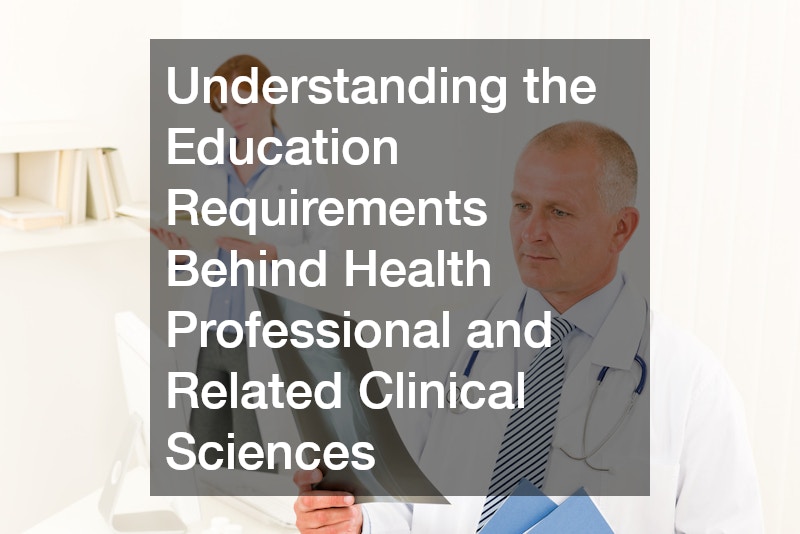
Navigating through the complex and dynamic world of health professions and related clinical sciences is essential to understanding the interwoven roles that contribute to the health and well-being of individuals. From obstetric care to pediatric services, each segment within the healthcare system plays a crucial role. This comprehensive exploration delves into various specialties, providing insights into their significance and interconnectedness. Each of these health professions not only requires specialized knowledge and skills but also plays a vital part in ensuring the holistic care of patients. Understanding the diversity and functions of these fields allows us to appreciate the intricate tapestry that makes up modern healthcare. Throughout this article, key aspects of health professions and related clinical sciences will be unraveled, emphasizing the importance of collaboration and innovation in advancing patient care.
OBGYNs

OBGYNs, or Obstetricians and Gynecologists, are integral to obstetric care, providing medical expertise in managing pregnancy, childbirth, and postpartum recovery. These specialists are essential in the health professions and related clinical sciences due to their role in ensuring both maternal and neonatal health. Their training and experience allow them to handle a wide range of conditions, from routine care to high-risk pregnancies, ensuring the safety and well-being of both mother and child.
The demand for skilled OBGYNs continues to grow as the healthcare community seeks to improve maternal health outcomes and reduce complications during childbirth. This specialty requires an in-depth understanding of a woman’s reproductive system, along with the ability to provide comprehensive care throughout the various stages of a woman’s life. With technological advancements, OBGYNs now employ a variety of innovative techniques and tools to enhance obstetric care, from prenatal screenings to advanced surgical procedures.
Despite the challenges they face, OBGYNs remain committed to the health and well-being of their patients. Their expertise not only contributes to successful pregnancies but also encompasses preventive care, early detection of reproductive health issues, and education on women’s health. This commitment underscores the importance of OBGYNs within the domain of health professions and related clinical sciences.
Levels of Nursing
Nursing is a cornerstone of healthcare, with nursing certifications playing a pivotal role in defining the scope and capacity of various nursing levels. From Licensed Practical Nurses (LPNs) to Advanced Practice Registered Nurses (APRNs), each level is distinguished by its training and responsibilities in providing patient care. The workforce diversity within nursing illustrates the significance of health professions and related clinical sciences in addressing patient needs across settings.
LPNs typically provide basic nursing care, assisting patients with daily living activities under the supervision of Registered Nurses (RNs) and doctors. Their role is crucial in supporting the broader team by delivering compassionate care and ensuring patient comfort. As nurses progress to RNs, they gain deeper insights and expertise, capable of managing patient treatment plans and educating patients and their families on healthcare needs.
Advanced practice nurses, such as Nurse Practitioners (NPs) and Clinical Nurse Specialists (CNSs), bring specialized knowledge to the healthcare environment. They often focus on specific patient populations or complex health issues, providing high-level care and contributing to enhanced patient outcomes. The collective contributions of these nursing levels underpin the effectiveness and reach of health professions and related clinical sciences.
Massage and Acupuncture
Massage therapy and acupuncture have emerged as complementary health professions and related clinical sciences, contributing to holistic patient care. These alternative therapies are increasingly recognized for their ability to alleviate pain, reduce stress, and improve overall well-being. With growing evidence supporting their efficacy, more healthcare providers integrate massage therapy and acupuncture into their treatment protocols.
Massage therapy involves the manipulation of soft tissues to promote relaxation, relieve muscle tension, and enhance circulation. It is widely used in various clinical settings, including rehabilitation centers and wellness clinics, to support patients in recovery and prevent further injury. The therapeutic benefits of massage therapy are well-documented, making it a valued component within comprehensive care plans.
Acupuncture, an ancient practice rooted in Traditional Chinese Medicine, involves the insertion of thin needles at specific points on the body to restore balance and improve health. It is used to treat a wide range of conditions, from chronic pain to mental health disorders, highlighting its versatility in the health professions and related clinical sciences. As patients seek more holistic approaches to healthcare, the integration of massage therapy and acupuncture gains traction, enhancing overall patient outcomes.
Repair Tissue

Innovations in stem cell therapy are revolutionizing the field of tissue repair, marking a significant advancement in health professions and related clinical sciences. Stem cells, with their ability to differentiate into various cell types, hold the potential to regenerate damaged tissues and organs. This cutting-edge therapy has shown promise in treating degenerative diseases, traumatic injuries, and certain chronic conditions.
The application of stem cell therapy spans numerous medical disciplines, offering hope for patients with limited treatment options. In orthopedics, for instance, stem cells are used to stimulate cartilage growth and repair bone damage, addressing conditions like osteoarthritis and fractures. Similarly, in cardiology, research explores the potential of stem cell therapy to regenerate heart tissue following infarction, aiming to improve cardiac function and patient prognosis.
Despite its potential, stem cell therapy also presents ethical and technical challenges that need to be addressed to fully realize its benefits. Ongoing research and clinical trials continue to seek solutions to these challenges, ensuring the safe and effective application of this promising treatment. As advancements in stem cell therapy progress, they underscore the innovation and progress inherent within health professions and related clinical sciences.
Health Transport
Medical transportation services are vital within the network of health professions and related clinical sciences, facilitating timely and efficient patient transfers. These services encompass emergency transport, non-emergency patient transfers, and long-distance medical transport, each serving a distinct purpose in the continuum of care. Ensuring patient safety and comfort during transport is paramount, necessitating well-trained medical transportation personnel.
Emergency medical transportation, provided by ambulance services and air medical units, is critical for responding to acute medical emergencies. These services ensure patients receive rapid, life-saving interventions en route to medical facilities, often determining patient outcomes. Non-emergency medical transport supports individuals with mobility challenges, offering accessible travel to routine healthcare appointments, thereby improving healthcare access and adherence to medical regimens.
The integration of advanced technology, such as GPS navigation and real-time patient monitoring systems, enhances the efficacy of medical transportation services. By optimizing routes and tracking patient vitals, these technologies contribute to improved operational efficiency and patient care. As medical transportation services evolve, their contribution to health professions and related clinical sciences remains indispensable.
Administrative Healthcare
Administrative roles within healthcare, such as medical inventory tracking, form the backbone of efficient healthcare systems. These roles involve managing the logistics of medical supplies, equipment, and pharmaceuticals, ensuring that healthcare facilities operate smoothly. Accurate and effective inventory management is crucial to prevent shortages, reduce waste, and control costs, thus supporting optimal patient care.
Healthcare administrators utilize various technologies, including inventory management software and automated tracking systems, to streamline operations and maintain accurate records. These tools facilitate forecasting demand, optimizing stock levels, and improving procurement processes, aligning with the broader goals of health professions and related clinical sciences. The implications of effective inventory management extend beyond financial savings, directly impacting patient safety and care quality.
As healthcare institutions face increasing pressure to enhance efficiency and reduce costs, the role of administrative healthcare professionals becomes more prominent. They act as pivotal players in implementing policies, procedures, and strategies that drive improvements in healthcare delivery. The success of these efforts reflects a commitment to excellence within health professions and related clinical sciences.
Cosmetics in Health

The role of cosmetic dentists within health professions and related clinical sciences underscores the intersection of aesthetics and functional health. Cosmetic dentists focus on improving the appearance of patients’ teeth, gums, and smiles, enhancing both self-esteem and oral health. This specialty emphasizes the importance of a holistic approach to patient care, addressing both visual and clinical aspects of dental health.
Cosmetic dentistry techniques, such as teeth whitening, veneers, and dental implants, are utilized to address various aesthetic concerns. These procedures often improve oral functionality by correcting alignment issues, improving bite, and facilitating better oral hygiene. As patient demand for aesthetic dental improvements grows, cosmetic dentists play a crucial role in advancing dental science and technology.
The integration of digital technology, such as 3D imaging and computer-aided design, has revolutionized cosmetic dentistry. These advancements allow for precise treatment planning and execution, ensuring optimal results and patient satisfaction. Cosmetic dentists, through their expertise, contribute to the enhancement of health professions and related clinical sciences by merging artistry with science.
Pediatrics
The specialized field of pediatrics is vital within health professions and related clinical sciences, focusing on the medical care of infants, children, and adolescents. Pediatricians are dedicated to monitoring growth and development, addressing health concerns, and preventing illness in young patients. Their role involves collaboration with childrens dentists and other specialists to ensure comprehensive care tailored to the unique needs of this patient population.
Pediatric care includes regular health check-ups, vaccinations, and treatment for various acute and chronic conditions. Family-centered care is a hallmark of this specialty, recognizing the impact of familial, social, and environmental factors on a child’s health. Pediatricians play a crucial role in educating families about nutrition, safety, and disease prevention, fostering a foundation for lifelong health.
Advancements in pediatric medicine continue to improve outcomes for children with complex medical conditions. Innovative treatments and early detection strategies significantly enhance quality of life and health potential. The dedication of pediatricians and their commitment to child health highlight their essential contribution to health professions and related clinical sciences.
Overlapping Sectors
The intersection of dermatology and oncology demonstrates the impact of overlapping sectors within health professions and related clinical sciences. For instance, skincare for radiation treatment is critical in managing and mitigating side effects experienced by cancer patients. Dermatologists work alongside oncologists to develop skincare regimens that soothe and protect irradiated skin, ensuring patient comfort and treatment compliance.
Radiation therapy, while effective in targeting cancer cells, often causes skin irritation and damage in treated areas. Skincare protocols are essential to prevent or minimize these adverse effects, facilitating better patient experiences and outcomes. Collaborative efforts between healthcare providers ensure comprehensive strategies that prioritize patient well-being during cancer treatment.
The field of integrative oncology continues to evolve, integrating conventional and complementary therapies to enhance cancer care. The focus on holistic patient care reflects the strengths of health professions and related clinical sciences. By emphasizing a multi-disciplinary approach, healthcare providers can better address the complex needs of cancer patients, improving the overall quality of care.
Radiology

The specialty of vascular interventional radiology is a noteworthy component of health professions and related clinical sciences, offering minimally invasive treatment options for various conditions. Interventional radiologists use imaging guidance to perform procedures that diagnose and treat vascular and nonvascular diseases. This specialty exemplifies the integration of technology and medicine, improving patient outcomes while minimizing recovery times and complications.
Advances in imaging techniques, such as CT scans and MRIs, have significantly enhanced the capabilities of vascular interventional radiologists. These precise imaging modalities allow for targeted interventions, such as angioplasty and stent placements, which are vital for managing cardiovascular diseases. The growth and accessibility of these procedures have revolutionized treatment methodologies, offering patients less invasive options with quicker recovery times.
The focus on patient-centric care is evident in the approach of vascular interventional radiology, which prioritizes effectiveness and safety in treatment. This discipline is continually expanding, driven by ongoing research and technological innovations. As it evolves, the contributions of vascular interventional radiology to health professions and related clinical sciences are immense, offering promising prospects for future healthcare advancements.
The diverse fields encompassed within health professions and related clinical sciences highlight the immense spectrum of services and specialties that collectively enhance patient care. From obstetric care provided by OBGYNs to innovative advances in stem cell therapy, the integration of various disciplines underscores the continual evolution of healthcare. Each segment contributes unique strengths and perspectives, fostering an interdisciplinary approach essential for addressing the complex health needs of diverse populations.
As healthcare continues to advance technologically and methodologically, collaboration among healthcare professionals and the integration of novel treatments and technologies become increasingly significant. This synergy not only improves the efficacy of patient care but also enhances patient experiences and outcomes, reinforcing the importance of health professions and related clinical sciences.
Ultimately, the collective efforts of these interrelated fields aim to foster a healthcare landscape that prioritizes innovation, compassion, and comprehensive care. As this landscape continues to evolve, it remains imperative to appreciate the interconnectedness and contributions of each specialty, ensuring the sustained growth and development of health professions and clinical sciences for future generations.



